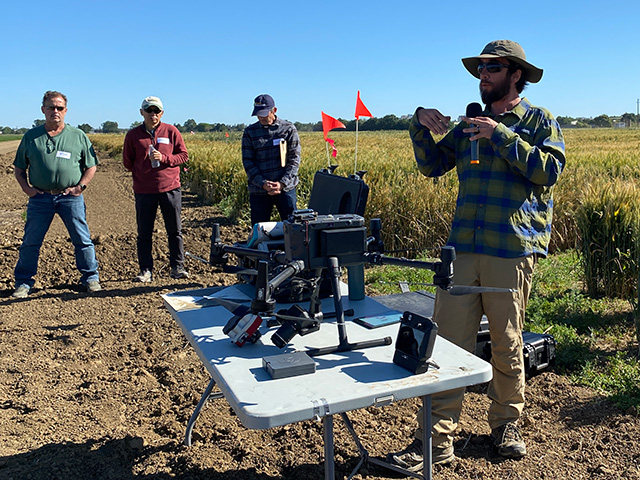Davis, California, USA
May 10, 2024
 Alicia del Barco is looking for better varieties of malting barley to serve the needs of craft brewers and the malting industry. She's a research scientist in the UC Davis Department of Plant Sciences. (Trina Kleist/UC Davis)
Alicia del Barco is looking for better varieties of malting barley to serve the needs of craft brewers and the malting industry. She's a research scientist in the UC Davis Department of Plant Sciences. (Trina Kleist/UC Davis)
Wheat was the first Western crop planted in California more than 250 years ago, and it’s still a strong contender for growers seeking options as temperatures get hotter and water turns more salty and scarce, researchers at UC Davis told growers and industry representatives this week.
“We’ve got a crop that can be scaled and that serves multiple purposes,” as both food for people and forage for animals, said Mark Lundy, an associate professor of Cooperative Extension in the Department of Plant Sciences. “There are lots of markets for forage and grain in California and across the country. It offers ecosystem benefits such as water infiltration, and pulls out nitrates from the soil and puts them to more productive uses.”
 Josh Hegarty, of the UC Davis Department of Plant Sciences, uses a drone equipped with an RBG camera to collect data on small test plots of grains. (Trina Kleist/UC Davis)
Josh Hegarty, of the UC Davis Department of Plant Sciences, uses a drone equipped with an RBG camera to collect data on small test plots of grains. (Trina Kleist/UC Davis)
And for growers weighing where to flow their shrinking water allotments or whether to fallow their land, wheat and other small grains can give them flexibility to deal with unexpected conditions of rainfall and adapt as the growing season evolves.
During the UC Davis Small Grains/Alfalfa Field Day this week, Lundy and other scientists offered advice for planting and irrigating to get the best possible crop despite tough conditions. They also offered hope in the form of new varieties of grains being developed, as well as management techniques that meet the many challenges farmers face.
Small grains research updates
Research updates presented in the area of small grains included:
Malting barley: Alicia del Blanco and team are developing malting barley that has better disease resistance and yield, and also superior malting quality. In recent years, they have released UC Tahoe, Butta 12, UC Capay and UC Alameda to serve California’s fast-growing craft brewers and malting industry. These four varieties have been bred to not produce a natural substance, glycosidic nitrile or GN, that usually occurs naturally in barley and which, in the distilling process, can lead to potentially toxic compounds. "We developed molecular markers to select for this trait and keep it in our UC Davis germplasm," Del Blanco said. She is an assistant project scientist in the lab of Jorge Dubcovsky, working under the leadership of small-grains breeder Xiaofei Zhang.
Drones over grains: Josh Hegarty explained how researchers are using drones equipped with special cameras to fly over small research plots and detect slight variations in color. “We can get data faster and at less cost,” Hegarty said. The team is assessing drought tolerance in hundreds of lines and collecting data at various points in the growth cycle, plus seeking varieties with better biomass and yield. Hegarty is a postdoctoral researcher in the Dubcovsky lab.
Non-allergenic wheat: Maria Rottersman discussed her work deleting genes from wheat that are responsible for creating some of the proteins that are most toxic for people with celiac disease. The resulting new varieties, Rottersman said, “we found were even better for bread-making qualities.” The highly successful UC Central Red wheat already has been updated to include this non-allergenic feature; next steps are to increase seed so researchers can conduct field trials. Eventually, broad availability of non-allergenic wheat will reduce the incidence of celiac disease in the overall population, she added. Rottersman is a graduate student in Dubcovsky’s lab.
 Maya Shydlowski, of the UC Davis Department of Plant Sciences, explains the water efficiency measurements she is taking in grain trials that will help growers meet California groundwater regulations. (Trina Kleist/UC Davis)
Maya Shydlowski, of the UC Davis Department of Plant Sciences, explains the water efficiency measurements she is taking in grain trials that will help growers meet California groundwater regulations. (Trina Kleist/UC Davis)
Dual-purpose wheat: Another UC Davis wheat variety, UC Central White, has been performing well in drought conditions, Hegarty said. Already an excellent wheat for bread and pasta, UC Central White is being further developed as a dual-purpose grain that can be used for forage as well. Researchers are looking for strains with reduced or absent awns – the thin, spiky protrusions at the end of the developing grain. “We hope in two to three years we’ll be able to release our first dual-purpose wheat,” Hegarty added.
Water use in winter grains: State groundwater regulations have prompted research to quantify water efficiency in the San Joaquin Valley. Graduate student Maya Shydlowski is measuring forage and grain productivity for varieties of wheat, triticale and barley in different combinations of planting date and irrigation levels. The trials also look at a grower’s economic return per unit of water, Shydlowski said. The project is led by Lundy and in collaboration with the Public Policy Institute of California.
Yield stability: Lundy and team have identified varieties of small grains and growth traits that are likely to offer stable yields despite nitrogen deficiency and drought. They illustrated the relationships among rapid and gradual grain filling periods, water and nitrogen limitations, and how these affect yield.
More resources
Read more about the work in the Lundy lab.
Read more about the work in the Dubcovsky lab.
Read here for more about the work in the Pittelkow lab.
Check out resources at the UC Small Grains Research & Information Center.